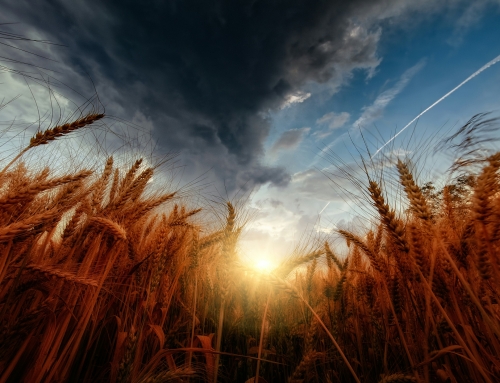Sermon Summary
John the Baptist and Elijah
Today with the title: John the Baptist and Elijah, I would like to think of the task of John the Baptist in light of Elijah’s course of transfiguration. Elijah was one of the 2 Old Testament figures who were transfigured, taken up to heaven without seeing death. Especially Elijah’s life and the ministry which foreshadows the end times saints in the process and path towards transfiguration. The reason why we are studying about John the Baptist is that Malachi the last prophet in the Old Testament prophesied that before the coming of the great and terrible day of the Lord (Messiah), Elijah will come back. Elijah who was taken up to heaven is going to come back as a sign to share the Word, to prepare the hearts of the people to return to the Father, and also to prepare the way of the Lord. Let’s think of John the Baptist and Elijah in the bible briefly and think of the transition from sin to righteousness.
1. Elijah who was to come again.
(Malachi 4:5-6) Elijah is to come to reconcile Father and His children, so there will not be judgment upon the people and God will not smite the land with a curse. Luke 1:17 is the angel speaking to Zechariah the father of John the Baptist, prophesying what he will do as a forerunner coming in the spirit and power of Elijah, repeating the prophecy of Malachi – to turn the hearts of the fathers to children, to make ready a people prepared for the Lord.
God sent Malachi as the prophet to check if the people are ready to receive the Lord (Messiah) who is the covenanted Seed of the woman. (Matthew 11:13-14, Matthew 17:10-13) John the Baptist is the prophesied Elijah who is to come again.
2. What was the task of John the Baptist as Elijah?
(i) The task of turning the heart of the father to the children and heart of the children to father – spiritual reconciliation.
(Malachi 4:5-6) He was to be the spiritual bridge to connect the hearts of the people to the Messiah, that is why he said of himself in John 1:23, a spiritual message as a hint. Isaiah 40:3. He is a voice but according to the Hebrew language expressed in Psalm 19:4, the word “voice” can be translated as “line”. Like a bridge, a line connects from the people to the Father, and from the people to the Messiah.
(ii) The task of the one crying in the wilderness. This voice says to clear the way for the Lord in the wilderness.
John the Baptist cried out the truth in the Judean wilderness, he preached the message of repentance and the message of the coming of the Messiah. John 1:19-24. The purpose of the law and prophets in the Old Testament is to prepare the people to receive Jesus, to cultivate and prepare the heart of the people to receive the promised seed. John the Baptist comes and gives those 2 messages.
(iii) The 3rd task of John is to become the end of the law and prophets.
It does not mean to abolish the law but graduating from the law to a higher level. Matthew 11:13. Luke 16:16. There needs to be such a transition in our lives too, from condemnation to righteousness. That is why this baptism is very important. The gospel is the fulfilment of the Old Testament laws. We are sinners but this regime will end with the Messiah. Romans 5:12-13.
(iv) The task of preparing the way of the Lord.
Leading people to understand who Jesus is, that Jesus is Christ the Messiah. Mark 1:1-4. John the Baptist appeared in the wilderness to preach repentance. Jesus Christ came to give us that righteousness but we need to come to Him to receive forgiveness of our sins first. Matthew 1:21, Matthew 9:13. John the Baptist appeared in the wilderness preaching repentance. Baptism symbolizes resurrection. Mark 1:7-8. That was John the Baptist’s task, bringing people to Jesus Christ, preparing the way for the Lord.
3. Elijah’s journey to transfiguration.
Let’s think briefly of Elijah’s life:
(i) Background of the time of Elijah.
It was during wicked King Ahab’s time, who foreshadows Anti Christ. It was a time of spiritual withering, dryness, famine. It was also the time of Jezebel who foreshadows the great harlot in Revelation, the fullness of idolatry and fallenness. The stages of Elijah’s journey can be summarized as:
• Brook Cherith
• Home of Widow of Zarephath
• Final battle at Mount Carmel
• Goes on a journey through the wilderness, comes to God and asks God to end his life at the broom tree
• Led by God to Mount Horeb and hears the still small voice
• Final stretch ending in transfiguration
This is a similar path that we need to take in the end to transfiguration.
(ii) Nourishing at Brook Cherith.
a. First, it was a hiding place in the wilderness where there is water. 1 Kings 17:3, 14. Elijah was to find rest and nourishing. God said there will be no rain, famine but during this time Elijah was fed and nourished. He was being prepared for something.
b. He is nurtured and nourished. Elijah was given food by ravens. Ravens are unclean birds. Even though they are considered unclean animals, they are like tutors. Apostle Paul referred to the Old Testament law as a tutor in Galatians. Brook Cherith represents that stage for Elijah. A place of training and learning.
Illustration of forefathers going through training in the bible:
• Adam was given all kinds of trees to eat from in the Garden of Eden.
• Noah’s training is in the process of building the ark.
• Abraham’s process was his obedience and separating from his worldly attachments.
• Jacob’s 20 years at Laban’s house, labouring under this wicked man.
• Joseph in Potiphar’s house and the prison before becoming the prime minister of Egypt.
• Moses’ 40 years in the Midian wilderness, God allowed him to wait as though Moses was forgotten.
• 40 years in the wilderness was a time to take out Egypt from the Israelites.
• Apostle Paul after his conversion and received Jesus on the road to Damascus, spent 3 years in Arabia confessed it was Christ who lived in him. Galatians 1:17-20.
• For saints in end times, it is represented by Apostle John who receives the little book and eats it, he is to prophesy again and goes through the time of prophesying and battle with the beast. Revelation 12 speaks of the woman clothed with the sun, this is speaking of the first 3.5 years where she is taken to the wilderness to be nourished. Revelation 13 speaks of the beast coming up, and the second 3.5 years of the tribulations begin.
Conclusion
There is a need for transition from the law to love of Jesus Christ through John the Baptist. As we have seen, the Old Testament time under the law and prophets was a time of preparation for the coming Messiah (the truth, the seed, the promise, the covenant to be fulfilled). People were stuck with this law, although they did not keep it correctly. So there needs to be a transition of letting go of that law and grabbing hold of the gospel. The law and prophets were like guardrails to make sure they stayed on track of this covenant. Apostle Paul called it a tutor. Galatians 3:24-25. So the tutor of the law leads us to that faith in Jesus Christ, and now that faith has come we are no longer under that tutor.
It is not the law of Christ but the love relationship of Christ in us that compels us to do things and makes us refrain from evil. It is not ethics but love. John the Baptist was to be the end of the law so people could receive true love and restoration through the relationship with Jesus. Through this Word and Holy Spirit, practise love, fulfil love in your life. May your reason for living a life of Christianity, your reason for following Jesus Christ be the love of Christ in us.
AMEN





